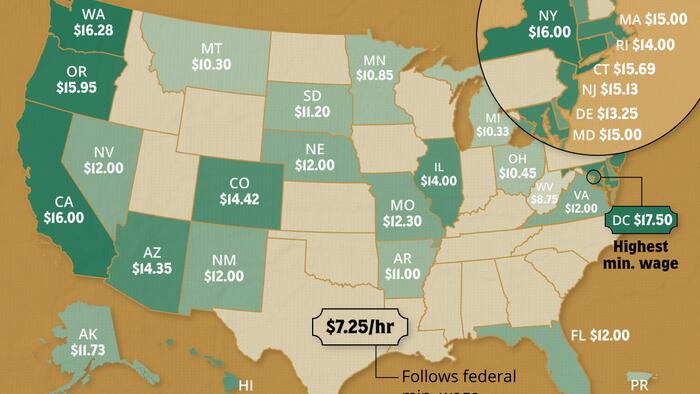The federal minimum wage in the United States, set at $7.25 per hour, has experienced a significant decline in purchasing power due to inflation and rising living costs since it was last raised 15 years ago. As the national conversation about the necessity of increasing this wage continues, individual states have taken proactive steps by implementing or raising their own minimum wages, leading to a diverse landscape across the nation. According to a detailed report by Visual Capitalist, as of 2024, thirty states have established a minimum wage higher than the federal threshold, with Washington State leading at an impressive $16.28 per hour, followed closely by California at $16.00. Moreover, Washington D.C. asserts the highest minimum in the country, currently set at $17.50 per hour, which is indexed to inflation—a strategy aimed at ensuring that minimum wage earners maintain their purchasing power in light of ongoing economic changes.
The variation in state minimum wages reflects the differing living costs across the United States. In states like Washington and California, where the cost of living is notably high, the higher minimum wages are viewed as crucial to helping workers meet their basic needs. In direct contrast, some areas maintain minimum wages at the federal level or lower; for instance, Wyoming and Georgia have state minimums that fall below $7.25, thus defaulting to the federal rate. Notably, eighteen states do not have a specific state-mandated minimum wage, thereby allowing federal standards to govern pay for low-wage workers in those regions. This patchwork of wage policies illustrates the varying economic realities faced by workers across the country, where the impact of state-level decisions on the workforce can be significant.
The debate surrounding minimum wage increases centers around two principal arguments. Advocates for raising the minimum wage contend that higher pay for low-wage workers is essential for improving living standards, alleviating poverty, and reducing income inequality. They argue that modest increases to the minimum wage would have minimal negative effects on employment levels and may even stimulate overall consumer spending, thereby benefiting the economy. The pressing need for a wage increase has grown in urgency, as the current stagnation marks the longest period without an increase in federal minimum wage since its establishment in 1938.
Conversely, opponents of significant minimum wage hikes warn of potential consequences that could counteract proposed benefits. Their primary concern is that increased labor costs may lead to job losses, particularly harming low-skilled and young workers who could be priced out of the job market. Small businesses, which typically operate on tight profit margins, are particularly vulnerable to labor cost increases, and proponents of this viewpoint argue that raising the minimum wage could inadvertently elevate poverty rates for the most disadvantaged workers. The discourse over minimum wage levels encapsulates broader societal values around equity, opportunity, and the extent of government intervention in market dynamics.
Since 2017, efforts to elevate the federal minimum wage have been formalized through the introduction of the Raise the Wage Act in Congress, yet none of these attempts have successfully passed through the legislative process to date. Current proposals seek to raise the minimum wage to $17 per hour, which, if enacted, would make substantial changes to the wage landscape across various states. An analysis of the implications of such a change, particularly through the lens of states with lower wage thresholds, reveals that many workers could stand to benefit significantly from a federal increase.
In summary, the ongoing minimum wage debate remains critical in shaping the economic landscape of the United States. With thirty states already exceeding the federal minimum wage, and Washington D.C. leading with its indexed approach to inflation, the issue continues to engender passionate arguments on both sides. As states experiment with their wage policies in response to the stagnation at the federal level, the outcome of future proposals, such as the Raise the Wage Act, will be closely monitored for their potential to reshape economic realities for millions of workers across the nation. The dialogue surrounding minimum wage increases not only reflects current economic conditions but also shines a light on the values and priorities of society as it strives for greater equity and opportunity within the labor market.

